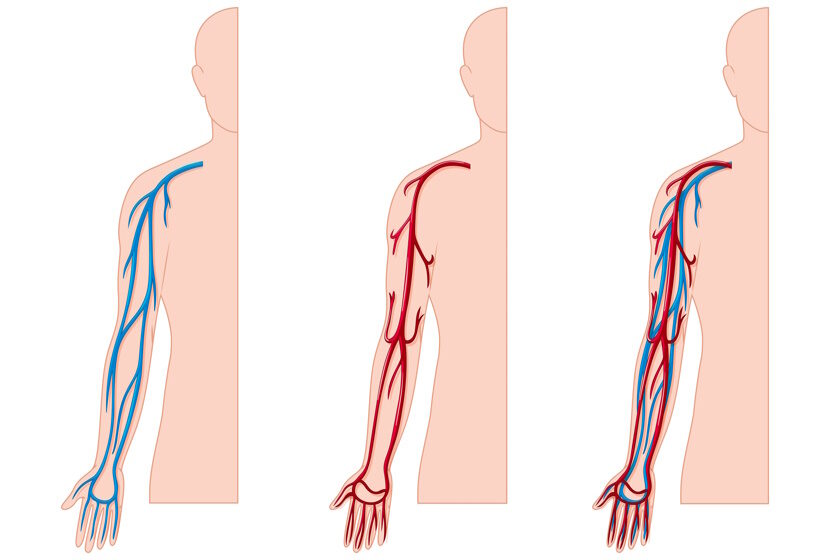
The Difference Between Veins And Arteries
What are Veins?
Veins are blood vessels that carry blood towards the heart. In the human body, there are two types of veins: deep veins and superficial veins. Deep veins are located deep within the body and are typically not visible, while superficial veins are located closer to the surface of the skin and are often visible. Veins also have valves in them that ensure the blood flows in the right direction, towards the heart.
What are Arteries?
Arteries are blood vessels that carry oxygenated blood away from the heart to the rest of the body. They have thick walls and are able to withstand the high pressure of the blood being pumped out of the heart. The largest artery in the human body is the aorta, which carries blood from the heart to the rest of the body. Other major arteries include the carotid artery, which supplies blood to the head and neck, and the femoral artery, which supplies blood to the legs.
Veins vs Arteries
Naming: The naming of the artery and vein also differ, Arteries as well as adjacent deep veins are often named after the organ or body part they serve, while superficial veins are often named after the location of the body where they are found.
Veins and arteries are both types of blood vessels that are responsible for transporting blood throughout the body. However, there are some key differences in artery and veins.
Direction of blood flow: Arteries carry oxygenated blood away from the heart to the rest of the body, while veins carry deoxygenated blood back to the heart. An exception to this rule are the pulmonary arteries.
Blood flow: Blood flow in the arteries is generally faster and more turbulent than in the veins.
Blood pressure: Blood pressure is generally higher in arteries than in veins. This is because the heart pumps blood into the arteries with more force than it pumps it into the veins.
Wall thickness: Arteries have thicker walls than veins because they need to withstand the high pressure of the blood being pumped out of the heart.
Location: Deep veins are located deep within the body and are typically not visible, while superficial veins are located closer to the surface of the skin and are often visible. Arteries are typically located deeper in the body.
Presence of valves: Veins have valves that ensure blood flows in the right direction, towards the heart. Arteries do not have valves.
Color: Superficial veins typically appear blue or green because the blood in them is deoxygenated. Arteries, on the other hand, typically appear red because the blood in them is oxygenated.
Elasticity: Arteries have more elastic walls than veins. This allows them to expand and contract as blood is pumped through them, which helps to regulate blood pressure.
Function: Arteries play a crucial role in delivering oxygen and nutrients to the body’s tissues, while veins play a crucial role in carrying waste products and carbon dioxide away from the body’s tissues.
Size: Generally, arteries are larger in diameter than veins. This is because they need to be able to accommodate the high volume of blood being pumped out of the heart.
Also Read: What is a Vascular & Endovascular Surgeon?
What Do Arteries and Veins Have in Common?
Arteries and veins both have several similarities like:
Both are important for the body’s function: Both arteries and veins play crucial roles in the body’s circulatory system and are essential for maintaining the body’s overall health and well-being.
Both are blood vessels: Arteries and veins are both part of the circulatory system and are responsible for transporting blood throughout the body.
Both contain blood: Both arteries and veins contain blood, which is composed of red blood cells, white blood cells, platelets, and plasma.
Both are lined with endothelial cells: The inner lining of both arteries and veins is made up of a single layer of cells called endothelial cells. These cells help to regulate the flow of blood through the vessels.
Both are surrounded by smooth muscle: The walls of both arteries and veins are surrounded by smooth muscle, which helps to regulate the diameter of the vessels and control blood flow.
Both are part of a network: Both arteries and veins are connected to one another in a network, which allows blood to flow throughout the body.
Problems associated with Veins and Arteries
There are several problems that can occur with veins and arteries in the human body, some of the common problems are:
Atherosclerosis: This is a condition in which the walls of the arteries become thickened and clogged with plaque, making it harder for blood to flow through. This can lead to high blood pressure, heart attack, and stroke.
Varicose veins: This is a condition in which the veins in the legs become enlarged and twisted, making them visible through the skin. Varicose veins can be uncomfortable and can lead to blood clots.
Deep vein thrombosis: This is a condition in which a blood clot forms in the deep veins, usually in the legs. It can be serious and lead to a pulmonary embolism if the clot becomes dislodged and travels to the lungs.
Aneurysm: An aneurysm is a bulge or ballooning in the wall of an artery. Aneurysms can occur anywhere in the body, but are most common in the aorta.
Raynaud’s disease: This is a condition that affects the blood vessels in the fingers and toes, causing them to narrow, reducing blood flow and causing pain, tingling, and numbness.
Peripheral Arterial Disease (PAD) caused by the build-up of plaque, fatty deposits on the inner lining of the arteries, which can restrict or block blood flow to the limbs.
These problems can be caused by various factors, such as genetics, lifestyle, and age. They can be treated with medications, surgery, or lifestyle changes, depending on the severity of the condition. It’s important to consult a Vascular & Endovascular Specialist Doctor if you suspect you have any of these problems.
In conclusion, veins and arteries are both types of blood vessels that are responsible for transporting blood throughout the body. They have some key differences, such as the direction of blood flow, the thickness of their walls, the presence of valves, and their location in the body. However, they also share some similarities, such as being part of the circulatory system, containing blood, being lined with endothelial cells, being surrounded by smooth muscle, and being part of a network that allows blood to flow throughout the body. Both of them are important for the body’s overall health and well-being, and maintaining their proper function is essential for maintaining good health.
Also Read: How is Critical Limb Ischemia treated?
Who can treat disease related to Arteries and Veins?
A vascular and endovascular specialist, also known as a vascular surgeon, is a medical doctor who specializes in the diagnosis and treatment of disorders of the blood vessels, including the veins and arteries. They are trained to perform a wide range of procedures, both surgical and non-surgical, to diagnose, treat and prevent vascular diseases.
Vascular and endovascular specialists typically complete a three-year general surgery residency followed by an additional two-year fellowship in vascular surgery. During this time, they learn to use advanced diagnostic techniques, such as ultrasound and angiography, to evaluate blood vessel problems. They also learn how to perform a wide range of procedures, including open surgery, endovascular surgery, and minimally invasive procedures.
Vascular and endovascular specialists have a deep understanding of the anatomy and physiology of the blood vessels, which makes them well-suited to diagnose and treat a wide range of conditions. They treat diseases of the aorta, carotid artery, iliac artery, renal artery, limb ischemia, and more. They also specialize in treating varicose veins, deep vein thrombosis, and other venous diseases.
Vascular and endovascular specialists work closely with other healthcare professionals, including primary care physicians, cardiologists, neurologists, and interventional radiologists, to provide the best possible care for their patients. They are also actively involved in research, developing new treatments and techniques for vascular diseases. Dr. Sumit Kapadia is a renowned senior Vascular & Endovascular and Vein Specialist available at Aadicura Superspeciality Hospital, Vadodara, Gujarat, India.
Think Vascular Think Aadicura
Follow us on YouTube

MBBS, MS, MRCS, DNB-Fellow
Dr. Sumit Kapadia
Dr. Sumit Kapadia / MR KAPADIA SUMIT a gold-medalist from Baroda Medical College, obtained his general surgical training and senior residency from SSG Hospital, Vadodara.

MBBS, MS, MRCS, DNB-Fellow
Dr. Sumit Kapadia
Dr. Sumit Kapadia / MR KAPADIA SUMIT a gold-medalist from Baroda Medical College, obtained his general surgical training and senior residency from SSG Hospital, Vadodara.




